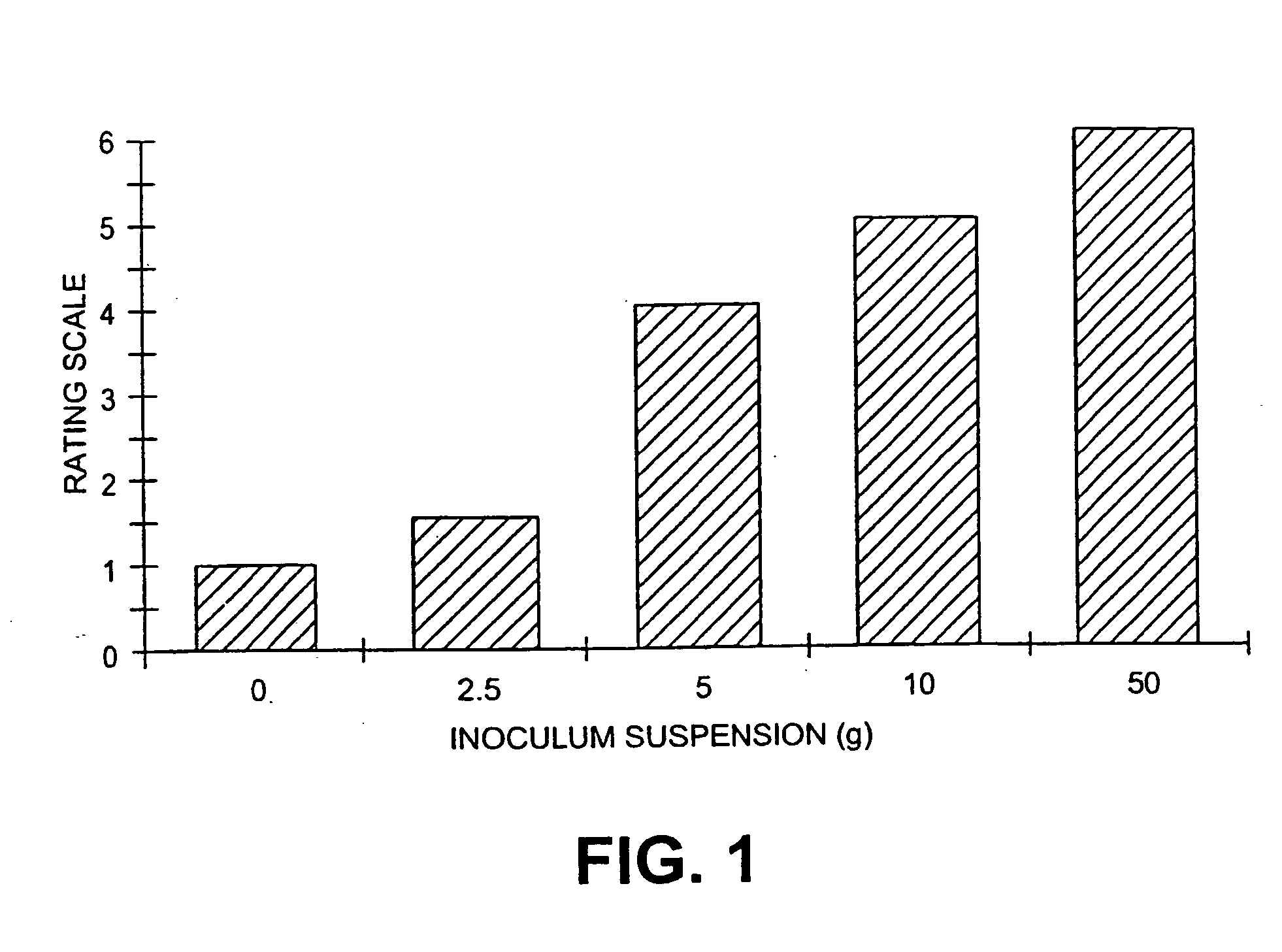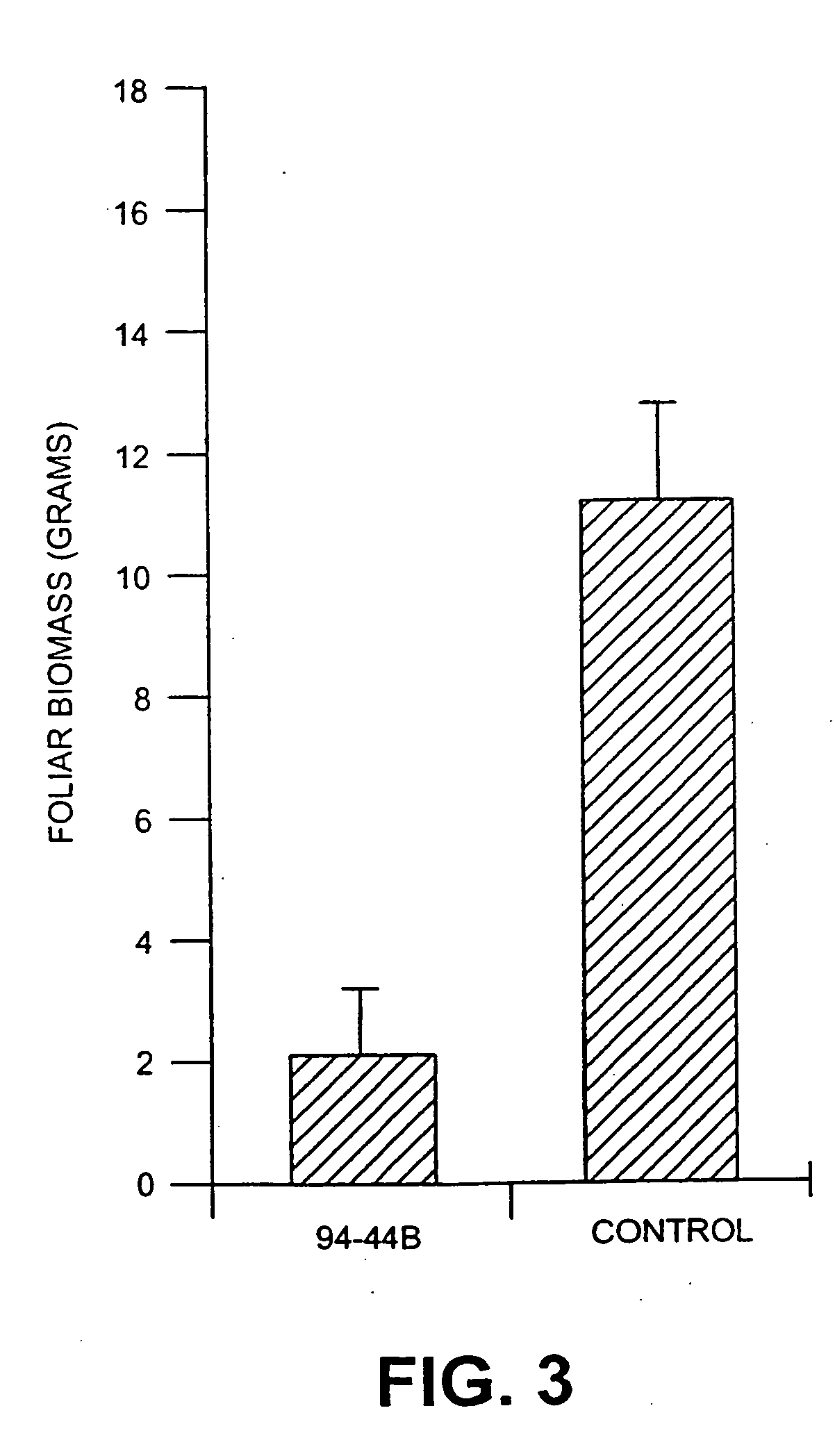Fungal isolates and biological control compositions for the control of weeds
- Summary
- Abstract
- Description
- Claims
- Application Information
AI Technical Summary
Benefits of technology
Problems solved by technology
Method used
Image
Examples
example 1
Isolation, Storage and Growth of Fungal Isolates Fungal Isolates
Fungal strains were isolated from small chlorotic and necrotic lesions on leaf and stem tissues of Canada thistle plants collected from fields, pastures, and roadsides. Purified fungi isolated from the plant tissues were verified to cause the disease symptoms using Koch's postulates.
TABLE 4Information on fungi isolated from Canada thistle.Host GrowthOriginalNameLocationHabitatStagesymptoms85-24BErwood, SKnot recordedfloweringleaf spots,chlorosis94-26Chatham, ONroadsidevegetativechlorosis94-44BMelfort, SKroadsideboltingchlorosis94-134St. Quentin, NBwaste fieldboltingchlorosis95-54A1Coldbrook, NSpasturebolting,foliarfloweringnecrosis97-12BValleyview, ABfallow fieldfloweringstem lesion89-25AItuna, SKfield cropvegetativeleaf spots94-359ARM 157, SKbarley fieldseed settingleaf spot,stem lesion95-268BRosthern, SKfiled cropfloweringleaf spot97-15B2Westlock, ABpasturefloweringstem lesion,top dieback
Isolation of Fungal Isola...
example 2
Control of Weed Growth using Fungal Isolates
Effect of Dose on Weed Control
Fungal isolates are grown on PDA and lactic acid for 10 to 14 days. The agar plates cultured with fungus are weighed into doses of 50 g (equivalent to an entire agar plate), 10 g, 5 g, 2.5 g, and 0 g (control), then macerated with sterile distilled water and each dose of the inoculum suspension is brought to a final volume of 50 mL. As an example, 85-24B is tested.
Roots are cut into appropriate lengths, for example roots of Canada thistle are 10 cm long, weighed and placed in 10 cm square pots filled with soil. A dose of the inoculum suspension is poured over the surface of the roots, covered with 1 cm soil, watered to saturation and placed in a greenhouse (20° C. day, 15° C. night; 16 hr daylight) with 6 replicates. Plant are rated for shoot emergence, chlorosis and death at 2, 4, and 6 weeks. At 6 weeks, roots are harvested and weighed. Results from this study using isolate 85-24B are presented in FIG....
example 3
Characterization of Weed Control Activity
Hulless Barley Bioassay
To prepare the barley for inoculation with a fungal isolate, soak hulless barley, for example but not limited to, barley cv. CDC Silky in distilled water. Drain off excess water and autoclave for 45 minutes at 121° C. for a total of three times. After autoclaving inoculate the flasks when they are cool.
To prepare the inoculum suspension, a two-week old agar culture plate is placed in a wide mouth bottle with sterile distilled water, and an antibiotic stock solution (streptomycin and vancomycin) is added and the agar antibiotic mixture is homogenized.
Inoculate each container of sterile barley grains with the homogenized inoculum suspension and incubate for two weeks under ambient lab conditions. After incubation, remove barley from container and spread infected grains in a thin layer over the tray to dry for 4 days under ambient room conditions. The dry grains are ground with a mill (i.e. Arthur H. Thomas Co.). T...
PUM
| Property | Measurement | Unit |
|---|---|---|
| Current | aaaaa | aaaaa |
| Current | aaaaa | aaaaa |
| Current | aaaaa | aaaaa |
Abstract
Description
Claims
Application Information
 Login to View More
Login to View More - R&D
- Intellectual Property
- Life Sciences
- Materials
- Tech Scout
- Unparalleled Data Quality
- Higher Quality Content
- 60% Fewer Hallucinations
Browse by: Latest US Patents, China's latest patents, Technical Efficacy Thesaurus, Application Domain, Technology Topic, Popular Technical Reports.
© 2025 PatSnap. All rights reserved.Legal|Privacy policy|Modern Slavery Act Transparency Statement|Sitemap|About US| Contact US: help@patsnap.com



